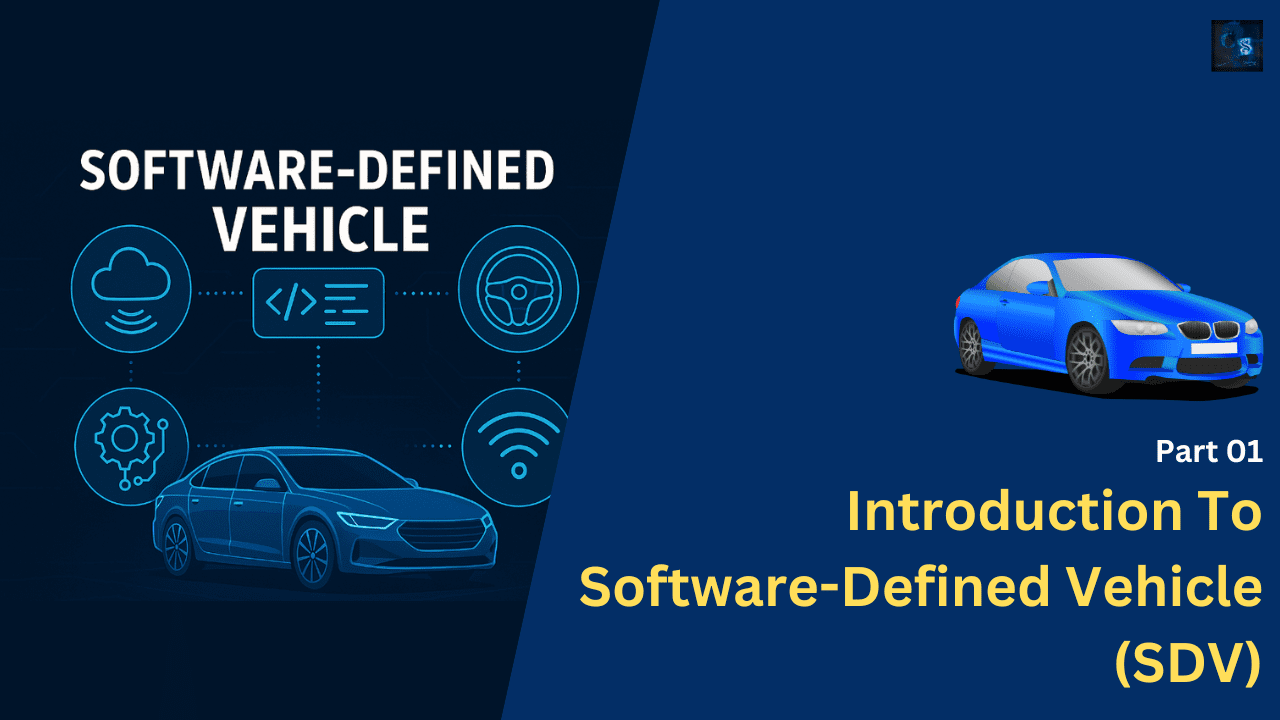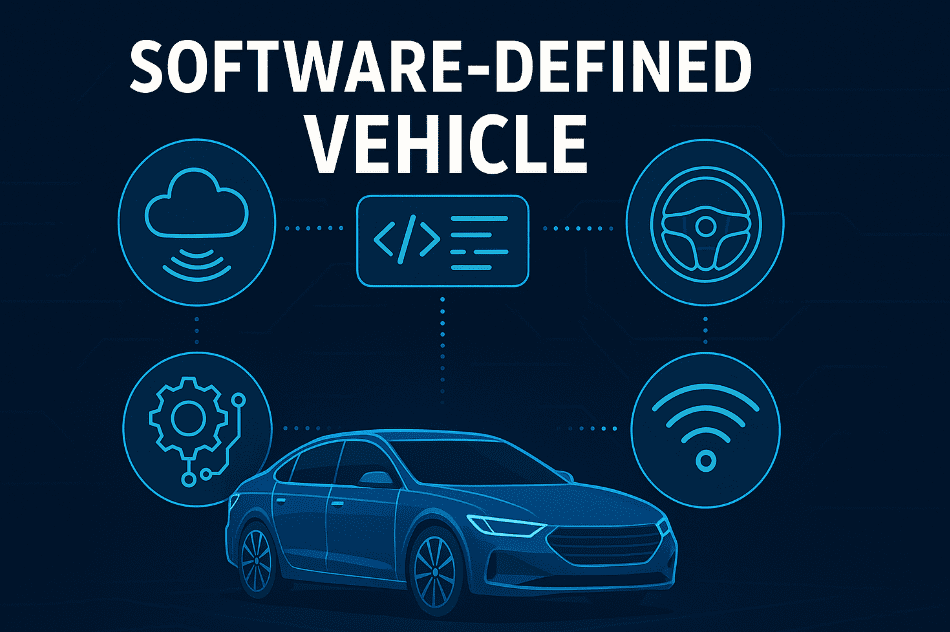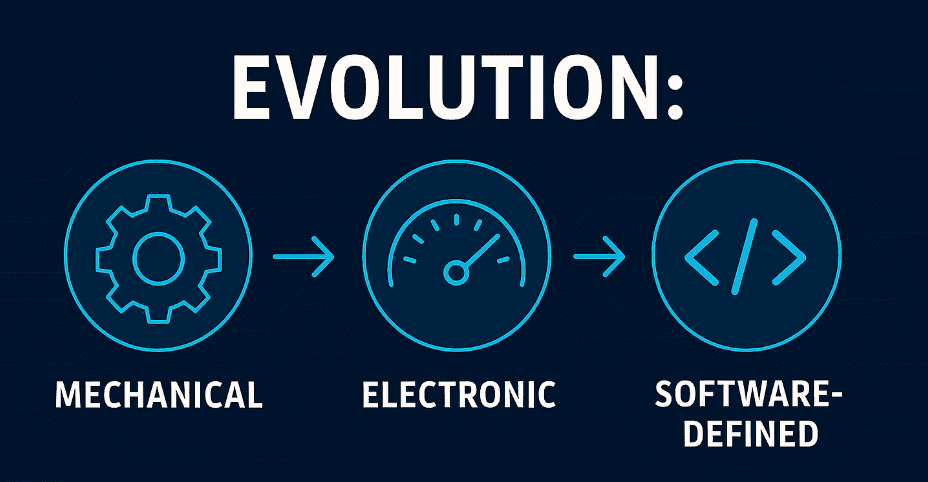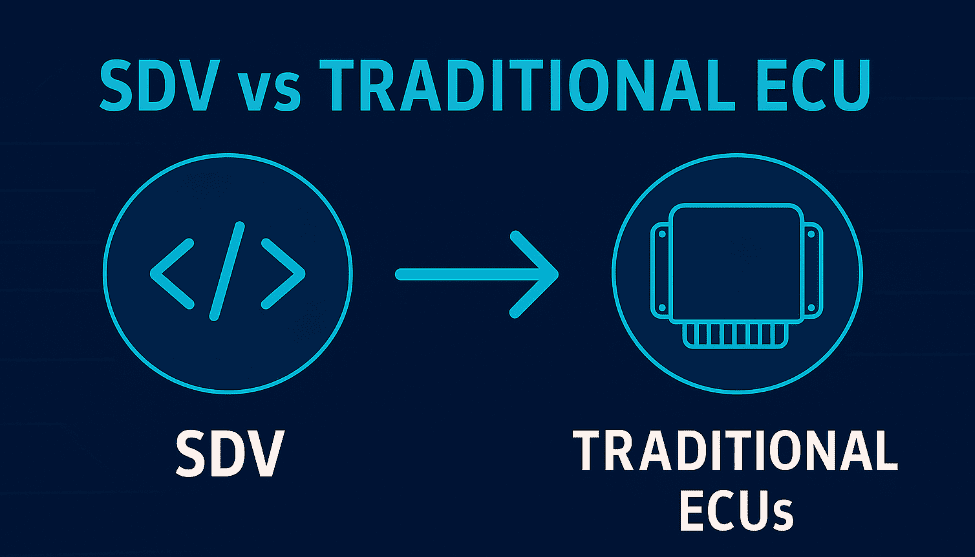Introduction To Software Defined Vehicle (SDV): Part 01
Hello guys, welcome back to my blog. In this article, I will discuss software-defined vehicles (SDV) and their evolution, and compare them with traditional ECU-based vehicles.
Ask questions if you have any electrical, electronics, or computer science doubts. You can also catch me on Instagram – CS Electrical & Electronics
- Difference Between A MEX and M Script File in MATLAB: A Complete Guide
- How a Half-Closed Door Reflects the Future of Autonomous Vehicle Safety
- Leading Brands In Automotive Microcontrollers
Introduction To Software-Defined Vehicle (SDV)
What is a Software Defined Vehicle (SDV)?
A Software Defined Vehicle (SDV) represents a transformative shift in the automotive industry where software becomes the central element driving vehicle functionality, performance, safety, user experience, and connectivity. Unlike traditional vehicles, where hardware dictated the capabilities of a vehicle, SDVs allow new features and improvements to be introduced through software updates, sometimes even without any hardware changes.
Core Concept:
At the heart of the SDV lies the principle of decoupling software from hardware. This allows for continuous innovation throughout the vehicle’s lifecycle. The SDV architecture prioritizes high-performance computing units, unified operating systems, centralized communication networks, and agile software deployment methodologies.
Key Characteristics:
- Centralized Computing Platforms: Instead of relying on multiple Electronic Control Units (ECUs), SDVs centralize computation in domain controllers or high-performance compute platforms.
- Software-Hardware Decoupling: Updates and enhancements are not tied to hardware refresh cycles.
- Over-the-Air (OTA) Updates: Similar to smartphones, vehicles receive software updates remotely.
- Dynamic Feature Activation: Owners can purchase and activate new features post-sale.
- Enhanced Diagnostics and Maintenance: Software monitors vehicle health and predicts failures before they occur.
The Role of Connectivity:
SDVs are inherently connected vehicles. Through high-speed internet connectivity (4G/5G), cloud platforms, and edge computing, SDVs continuously exchange data with external systems. This connectivity enables:
- Real-time navigation updates
- Vehicle-to-Infrastructure (V2I) and Vehicle-to-Vehicle (V2V) communication
- Remote access and control via mobile apps
- Data sharing for traffic management and insurance models
Industry Examples:
- Tesla: Pioneer in SDVs with consistent OTA updates, autopilot features, and infotainment enhancements.
- Volvo & Polestar: Utilize Android Automotive OS, offering app-based ecosystems within vehicles.
- Mercedes-Benz: Developing MB.OS will unify vehicle control and digital services.
- Volkswagen: Through CARIAD, aiming to transition into a software-oriented mobility provider.
Benefits of SDVs:
- Increased vehicle longevity through continuous upgrades
- Improved customer satisfaction via personalization
- Accelerated innovation cycles
- Lower cost of ownership over time
- Support for new business models (e.g., subscription services)
Real-World Applications:
- Adaptive cruise control improvements
- Self-parking updates
- Music streaming integration
- In-cabin health monitoring
- Smart climate control based on user profiles
SDVs are redefining the automotive experience, making vehicles smarter, safer, and more adaptive to user needs and environmental contexts.
Evolution: Mechanical → Electronic → Software Defined
The automotive industry’s evolution can be described in three broad phases, each marked by a significant technological paradigm shift.
- Mechanical Era (Late 19th Century – 1980s):
In the earliest automobiles, vehicle performance was driven entirely by mechanical systems:
- Engine control via carburetors
- Manual braking and steering systems
- Analog gauges
- Mechanical linkages and cables for control
Vehicles were purely mechanical marvels. Any enhancement requires physical redesign or component changes. Performance improvements were iterative and slow.
- Electronic Era (1980s – 2010s):
The introduction of electronics in vehicles transformed how key systems were controlled and monitored.
- Emergence of ECUs for specific functions (ABS, airbag systems, engine management, etc.)
- Digital dashboards and infotainment systems
- CAN bus for communication between ECUs
- Embedded software is tightly coupled to hardware
By the 2000s, vehicles contained upwards of 100 ECUs, each performing isolated tasks. While powerful, this led to challenges in integration, maintenance, and scalability. Software updates were rare and required dealership visits.
- Software-Defined Era (2010s – Present):
Driven by the digital revolution, vehicles began transitioning toward software-centric designs:
- Domain controllers (powertrain, ADAS, body, infotainment)
- Vehicle Operating Systems (e.g., AGL, Android Automotive, MB.OS)
- High-speed in-vehicle Ethernet replacing CAN in certain architectures
- Cloud-based data analytics for predictive diagnostics
- Agile and DevOps practices in automotive development
Key Trends in SDV Evolution:
- Zonal Architectures: Reduce wire harness complexity and improve serviceability
- Digital Twins: Simulated vehicle environments aid in testing and validation
- Edge Computing: Supports real-time decisions like collision avoidance and pedestrian detection
- Microservices & SOA: Software components become modular and independently deployable
Challenges of the Transition:
- Managing legacy vehicle platforms alongside new SDV architectures
- Supply chain realignment from mechanical/electronic to software-based partners
- Cybersecurity: SDVs are vulnerable to attacks if not properly secured
- Regulatory compliance across regions for OTA, data privacy, and software safety
Despite these challenges, the shift to SDVs is accelerating, supported by consumer demand for smarter mobility and regulatory pressure for safety and sustainability.
SDV vs Traditional ECU-based Vehicles
The transition from traditional ECU-based vehicles to SDVs is not just a technological shift but a complete overhaul in how vehicles are conceptualized, developed, maintained, and monetized.
Traditional Vehicles (ECU-based):
- Highly distributed systems
- ECUs manage specific functions (brakes, wipers, infotainment, etc.)
- Limited interaction between ECUs
- Long development cycles
- Manual feature deployment and recalls
- Tightly integrated hardware-software stacks
Software Defined Vehicles (SDVs):
- Centralized or zonal computing
- Unified control of vehicle domains
- Real-time analytics and cloud synchronization
- OTA updates and feature activations
- Platform-based approach for third-party integrations
- Virtualization of functions (e.g., software-based firewalls, simulated sensors)
Key Differences:

Example Use Cases:
- A traditional vehicle requires a service visit to enable fog lights or navigation maps.
- In SDVs, these features can be bought via an app and activated immediately via OTA.
Business Model Impact:
- Traditional OEMs: Revenue tied to one-time vehicle sales
- SDV OEMs: Subscription-based models for software features, apps, performance boosts, and more
New Opportunities:
- App Stores for Cars: Users can download vehicle-specific applications
- Data Monetization: Insights from user behavior and vehicle performance
- Fleet-as-a-Service: Remote management of fleets via SDV platforms
The transformation from ECUs to SDVs is akin to the shift from feature phones to smartphones, marking a generational leap in vehicle intelligence and adaptability.
Conclusion: The Future of SDVs
Software-defined vehicles are not merely a technological advancement—they represent a new era of mobility. With the convergence of AI, cloud computing, 5G, and real-time edge analytics, SDVs are becoming dynamic digital platforms on wheels.
Future Trends:
- Vehicle Operating Systems: OEMs developing proprietary platforms (e.g., MB.OS, VW.OS)
- AI-Driven Features: Adaptive driving behavior, in-cabin personalization, fatigue detection
- Digital Ecosystems: OEMs partnering with tech giants to offer seamless digital experiences
- Regulatory Evolution: Governments adapting to software regulation in the automotive space
- Cybersecurity Frameworks: Continuous protection against evolving threats
Final Thoughts:
As vehicles become more like smartphones and less like mechanical devices, the competition will shift from horsepower to computing power, from torque to terabytes, and from dealership to digital experience.
The companies that succeed will be those that master software, data, and ecosystem thinking. For engineers, developers, and businesses, SDVs present an enormous opportunity to redefine what it means to design, drive, and interact with a vehicle.
This was about “Introduction To Software-Defined Vehicle (SDV): Part 01”. Thank you for reading.
Also, read:
- Mini Project / Hands-on Demo for Software-Defined Vehicles (SDVs): Part 08
- Challenges And Opportunities In Software Defined Vehicles (SDVs): Part 07
- Case Study: Real-World Software-Defined Vehicle Examples: Part 06
- Software-Defined Vehicles Development Lifecycle: Part 05
- Software-Defined Vehicles Enabling Technologies: Part 04
- Core Software Layers In Software Defined Vehicles: Part 03
- Introduction To Software Defined Vehicle (SDV): Part 01
- Difference Between A MEX and M Script File in MATLAB: A Complete Guide




